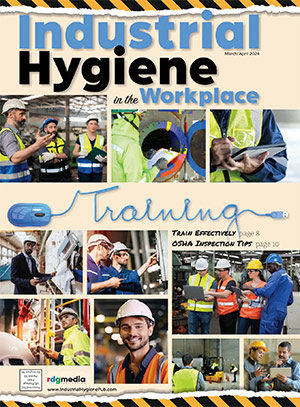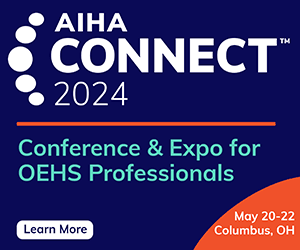Sampling Can Validate Workers’ Exposure to Air Contaminants
By: Ray Chishti, Contributor
Up-to-the-minute regulatory information helps companies stay in compliance and keep employees safe. New for 2023 and running every other issue, Regulatory Review will feature a different aspect of current compliance advice from the experts at J.J. Keller & Associates. –Barbara Nessinger, Editor-in-Chief
Safety professionals are more often wearing multiple hats in the workplace, now needing to understand complex IH issues such as sampling. Many workers wear respiratory devices, requiring employers to make a reasonable estimate of their workers’ exposure to airborne contaminants. Employers can use objective data, sampling data or mathematical computation to validate workers’ exposure levels. Hiring an industrial hygienist to do these things can cost upwards of $200 per hour, putting a strain on already tight facility budgets.
So, many workplaces require their safety professionals to learn how to acquire and interpret analytical data to validate workers’ exposures. Area and personal sampling are the most effective means of making this validation without using an industrial hygienist. Still, many safety professionals aren’t familiar with why learning how to sample, or even use basic sampling equipment, can be beneficial. An example of how it could benefit workplace safety is the recently emerging rulemaking activity from OSHA concerning its lead standards.
OSHA’s News Release
 In June 2022, OSHA published a news release that caused much concern for the industry. The Agency stated it was considering rulemaking to revise its general industry and construction standards for occupational exposure to lead based on medical findings since the Agency’s lead standards issuance. Recent medical findings show that adverse health effects in adults can occur at Blood Lead Levels (BLLs) lower than the medical removal level—and lower than the level required under current standards for employees to return to their former job status.
In June 2022, OSHA published a news release that caused much concern for the industry. The Agency stated it was considering rulemaking to revise its general industry and construction standards for occupational exposure to lead based on medical findings since the Agency’s lead standards issuance. Recent medical findings show that adverse health effects in adults can occur at Blood Lead Levels (BLLs) lower than the medical removal level—and lower than the level required under current standards for employees to return to their former job status.
OSHA held a comment period seeking comments from stakeholders on reducing the current BLL triggers in the general industry’s medical surveillance and medical removal protection provisions and construction standards for lead. OSHA also sought input about how current ancillary provisions in the lead standards could be modified to reduce worker BLLs.
Three of the four big issues that involve some level of sampling that affect OSHA’s final lead standards include:
- Removing workers from lead work sooner rather than later
- Monitoring triggers and frequency of workers’ blood lead levels
- Establishing a proactive permissible exposure limit
OSHA is also looking into PPE, housekeeping, hygiene and training. Knowing how to sample for contaminants can help safety professionals and employers ensure their reasonable estimates of airborne lead exposure are validated with analytical data.
Airborne Lead Exposure

Many workplaces require their safety professionals to learn how to acquire and interpret analytical data to validate workers’ exposures. Area and personal sampling are the most effective means of making this validation without using an industrial hygienist. (photo courtesy Adobe Stock Images)
An air contaminant is any substance—like lead—that is accidentally or unintentionally introduced into the air, making the air toxic or harmful to some degree. Lead work processes and activities are the main sources of airborne lead respiratory contaminants.
For General Industry employers, OSHA 1910.1000, Air contaminants, protects employees from occupational exposure to other air contaminants besides lead. The regulation applies to all workers who may be subjected to workplace air contaminants. Likewise, in the construction industry, 1926.55, Gases, vapors, fumes, dust, and mists, similarly applies to construction workers.
1910.1000 and 1926.55 list various substances along with permissible exposure limits (PELs) for an eight-hour period. Employers have a responsibility to notify their workers of potential hazards in the workplace, including air contaminants.
When employers and safety professionals require their workers to wear respiratory devices, OSHA requires that they make a reasonable estimate of workers’ exposure to air contaminants. This is more than just an educated guess. Use SDSs, work process, work exposure and other information to determine workers’ exposure levels. Confirm exposure level through:
- Sampling,
- Objective data or
- Mathematical calculation.
Once you know the exact exposure, you can determine whether workplace controls are effective and whether PPE is adequate or necessary. Among the three confirmation methods mentioned above, sampling will be the easiest method for employers and safety professionals to learn.
Sampling & OSHA’s Lead Standards Rulemaking

In June 2022, OSHA stated it was considering rulemaking to revise its general industry and construction standards for occupational exposure to lead based on medical findings since the Agency’s lead standards issuance. (photo courtesy Adobe Stock Images)
Lead is a heavy metal that can threaten workers’ health in many occupations. It can be inhaled or swallowed and, once inside the body, it tends to remain in tissues and organs. As exposure to lead continues, the amount stored in your body may increase. Eventually, after repeated exposures, lead build-up becomes toxic.
Even though workers may not be aware of any immediate symptoms of the disease, the lead stored in exposed workers’ tissues can be slowly causing irreversible damage. Damage occurs to individual cells, organs and the even entire body system. The exposure can damage the nervous system, kidneys, immune system, reproductive system and possibly cause cancer.
This irreversible damage is why OSHA is engaging in rulemaking activity to revise its general industry and construction lead standards. Removing workers from lead work sooner rather than later, when blood lead testing shows increased exposure to lead above its permissible exposure limit, is paramount in protecting workers proactively. Performing personal and area monitoring can allow employers and safety professionals to keep their lead workers safe before they get sick.
About the Author
Ray Chishti joined J. J. Keller & Associates, Inc. in 2017 as a Workplace Safety Editor. Previously, Ray worked as an EH&S professional in auditing, management and executive leadership positions with new construction, operating facilities and large EPC projects valued between $1-2 billion. He has over 18 years of EH&S experience in various industries, including fossil fuel power plants and utility distribution and transmission work. Ray’s experience also includes safety responsibilities in retail grocery stores, warehouse facilities, and the construction of a college campus. He holds a Juris Doctor with a concentration in Occupational Safety and Health and is also an OSHA-authorized trainer for general industry and construction, and has first aid, AED and CPR certifications.
Share on Socials!
Safe Industrial Plant Gas Monitoring
Dust, Fumes & Dangerous Gasses
Identify Combustible Dust Risks Lurking at Your Facility
Leaders in Industrial Hygiene
Council for Accreditation in Occupational Hearing Conservation (CAOHC)
Subscribe!
Sign up to receive our industry publications for FREE!








